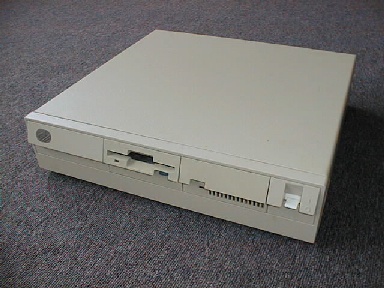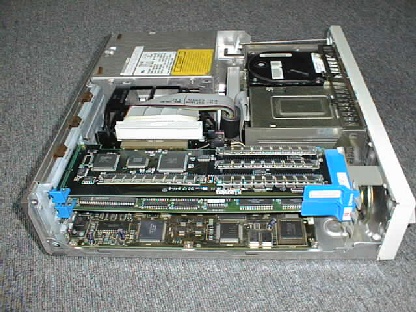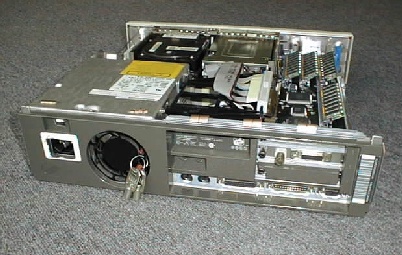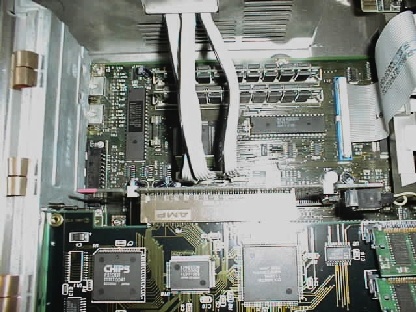
Click here or click onto the photo for a full size version of this picture.
The 55SX was the first PS/2 machine with an i386SX processor, Intel's stripped- down version of the i386DX processor. Since the CPU core is the same, you can run all 386 software on it, but at 16 MHz and with half the bus width, it's probably the slowest way of doing it... Nevertheless, for the time it was released, the 386SX was an economical choice, and for some time, it was the best-selling PS/2 machine - so a used 55SX is quite easy to obtain.
Historically, the 55SX came after the first-generation Model 50 and 70, and IBM took the chance to make a few changes to the case design: First, this was the first model with the slots oriented horizontally. This concept allowed to make a case whose height wasn't dictated by the height of the extension cards; the 55SX is much thinner than the 50/70, comparable to the ISA-based model 30, which makes the case look a lot 'smarter' and better-fitting into a styled secretary's bureau. Second, the main chassis is made of steel and not of plastic, maybe due to customer complaints who didn't want to have an all-plastic machine at IBM's prices? In its successors, the models 56 and 57, IBM used even more metal for the case - some people say they are built like a tank :-)

Click here or click onto the photo for
a full size version of this picture.
Looking inside, one can see that IBM removed the 50/70's internal hard drive bay and instead placed the ESDI drive into one of the accessable floppy bays, so you can't have two floppies and a hard drive at the same time. Remember the 55SX was designed as a low-end machine, so this compromise was quite acceptable.
The power supply is located in the case's rear right corner; a power supply similar to the 50/70 resp. 56 probably was impossible because the drive bays and the card space already occupied too much of the case's width. IBM however found a simple and elegant way to keep the power switch at the front: The real power switch is operated via a piece of steel wire which connects to the lever at the front. So in contrast to other constructions with low-voltage switches and standby supplies or 220V cables running through the machine, the mains voltage never leaves the power supply's case and the machine is really off when you turn it off :-)
The ESDI interface is laid out as an 'inverted slot' on the raiser's top edge; a flexible ribbon cable with an edge connector is plugged into it and runs to the hard drive which has the same connector. There were also variants of the 55SX which had a flexprint instead of a ribbon cable, but the connectors remained the same.
The 386SX CPU isn't visible in this photo; it is directly next to the coprocessor's socket int the front-left corner and hidden by expansion cards.

Click here or click onto the photo for
a full size version of this picture.
The back side of the 55SX doesn't reveal anything special: keyboard, mouse, parallel and serial port plus the VGA connector. There are also two break-out holes known from the 56 and other PS/2 machines; their purpose is to add a U-shaped piece of steel that is large enough to pull through a chain; this way, you can lock your machine to the table.

Click here or click onto the photo for
a full size version of this picture.
The 55SX has two PS/2 SIMM slots. Note that though the 386SX has just a 16-bit data bus, using 32-bit wide SIMMs are no problem (their pinout is already trimmed for such a configuration). Single-sided 1 Mbyte modules, double-sided 2 Mbyte modules, and single-sided 4 Mbyte modules are accepted; the larger 8M modules unfortunately not and you have to victimise a slot to get more than 8 Mbytes...
In case you pulled a 4M/70ns module out of another PS/2 and wonder why it doesn't work: Like the 65SX, the 55SX needs 4M modules coded for 80ns access time. Modifying the presence detection pins of a 70ns module is simple; see Peter Wendt's pages for a description of the presence detection codes.
- Processor:
- Intel i386SX @ 16 MHz
- Coprocessor:
- Intel i387SX @ 16 MHz
- Cache:
- none
- Memory:
- 4 Mbytes on-board (options range from 1M to 8M)
- Bus:
- 3 MCA slots (16 bit)
- Interfaces (onboard):
-
- Mouse, Keyboard
- 1 x Serial
- 1 x Parallel
- Floppy (1.44M)
- ESDI Hard Disk (DBA Interface)
- VGA
- Add-on cards:
-
- Novel NE/2 Ethernet Adapter
- Kingston Memory Expansion Board (currently 5Mbytes)
- Operating System(s):
-
- OS/2 Warp Version 3
- Useful Links: